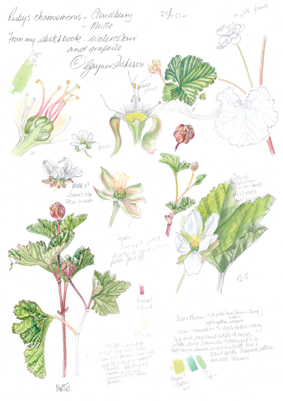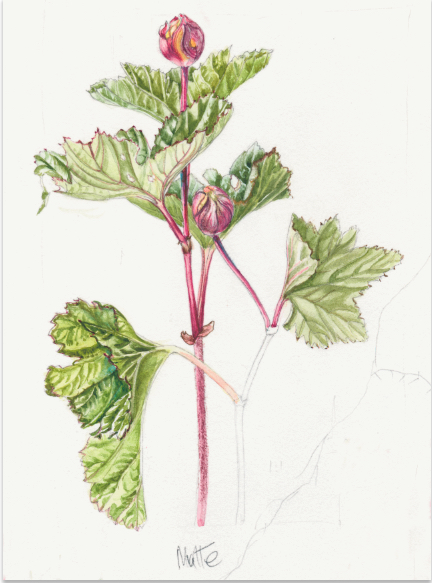
Rubus chamaemorus – Cloudberry -Multe
In Norway, Rubus chamaemorus is often referred to as ‘Mountain Gold’ because it doesn’t grow everywhere, it isn’t always easy to find and in some years is quite sparse. It is a delicacy and the one fruit that people would like to find and pick. If anyone finds an area which has a lot of ripe fruit, they normally keep it to themselves for fear of others picking the spot clean. Up until 2003 it was forbidden to pick the unripe fruit; this was changed as it was difficult to enforce. But in northern Norway where it has economic importance, the landowner can forbid picking.
Cloudberry is considered to be an endangered species (red-listed), it has a long, up to 10 metres, creeping rhizomatous root system and enjoys life best in sphagnum moss bogs. The species is dioecious with each plant either male or female. Although one generally sees the Male plant flowering every year, sometimes the female flowers are very sparse. But in the two last years, there has been a lot, relatively speaking, and if you know where to look!
Unripe, a Cloudberry is red, but as it ripens it becomes gold and it has a very distinctive flavour. Cloudberry is in the same family as Blackberries, so you will know that each drupelet has pips; once accustomed to the taste, one doesn’t mind the pips.

Male Cloudberry flower with ring of stamens. 
Open pink sepals with stamens remaining on male cloudberry flower.
My friends who lent me their cottage when I started the series, pointed out that there were lots of Cloudberry plants round the cottage, but they had never seen any fruit. I had a quick look at the flowers (the two photos) and was able to tell them that they only had male plants in the patch. But only a few metres away there were loads of female plants busily flowering and developing fruit. They were unaware that Cloudberries had distinct male and female plants, so I showed them how to tell the difference.
Obviously, the distinction between male and female plants was one of the things that I needed to show clearly in my final artwork. But in the meantime, I needed to do as many sketches as possible and of course take accurate measurements. In my pleasure at starting properly in 2017, I straightaway forgot the necessities and didn’t take measurements of my dissections. Unbeknown to me I wouldn’t be able to catch up for another five years in 2022! Luckily, this was the only plant where I seemed to chase my tail year after year.
The page of sketches, is a ‘Cloudberry’ poster showing a collection of drawings from my sketchbook.
I was particularly pleased with the plant sketch showing both leaves and very unripe fruit. But, apart from this initial sketch I didn’t see either unripe or ripe fruit until 2018 when I was given two fruit by passing pickers.
I did the trial on the vellum (at the top of the page) in 2021 when I at last found fruit to take back to the cottage. But I still needed flower measurements.


The pictures below show the area in which we found quite a lot of fruit in 2022.
Actually we were very surprised because we hadn’t had any rain since early autumn 2021 and all the lakes and reservoirs were pretty low. As you can see to the right, the moss was quite burnt on the surface, although there was still water deeper down. The area in which we were able to walk without getting too wet was much larger than the previous year. Global warming!!


The second part about the Cloudberry will be posted 4th May 2023.

Foraging for cloudberries has been a very enjoyable education in spectacular scenery. The bog area near Haglebu was interesting, at times it felt like walking on a potentially bottomless waterbed. Fortunately we never broke through and I look forward to going back again.